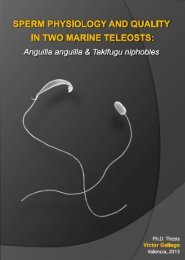TESIS DOCTORAL - RiuNet - Universidad Politécnica de Valencia
TESIS DOCTORAL - RiuNet - Universidad Politécnica de Valencia
TESIS DOCTORAL - RiuNet - Universidad Politécnica de Valencia
You also want an ePaper? Increase the reach of your titles
YUMPU automatically turns print PDFs into web optimized ePapers that Google loves.
Chapter 1<br />
abundant or mo<strong>de</strong>rate, more frequently arranged in chains than clusters (Fig. 1.2I).<br />
Aerial mycelium ranges from dark to light brown (Fig. 1.3K, L) (Crous and Wingfield,<br />
1993; Lombard et al., 2012).<br />
1.2.3.- Biology, epi<strong>de</strong>miology and host range<br />
Campylocarpon, “Cylindrocarpon”, Cylindrocladiella and Ilyonectria species<br />
are known to be saprobes in soil, which can occur on <strong>de</strong>ad plant substrata, or act as<br />
weak pathogens of plants infecting wounds of roots and stems of various hosts through<br />
wounds and/or openings (Fourie and Halleen, 2006; Halleen et al., 2006a, 2007a;<br />
Schroers et al., 2008; Probst et al., 2012). Furthermore, the production of<br />
chlamydospores in most species of these genera may allow them to survive for exten<strong>de</strong>d<br />
periods in soil (Halleen et al., 2004). However, very little information is currently<br />
available regarding the survival of these pathogens, and the role of chlamydospores<br />
during subsequent infections (Halleen et al., 2006a).<br />
Table 1.2. Summary of distinctive morphological and cultural features of “Cylindrocarpon”/Ilyonectria,<br />
Campylocarpon and Cylindrocladiella genera associated with black-foot disease of grapevines.<br />
Characteristics “Cylindrocarpon”/Ilyonectria Campylocarpon Cylindrocladiella<br />
Conidiophores 40–160 µm long, generally<br />
simple, unbranched or<br />
sparsely branched, irregularly<br />
or verticillately branched,<br />
rarely <strong>de</strong>nsely branched, and<br />
with cylindrical phiali<strong>de</strong>s<br />
Conidia<br />
Microconidia<br />
Abundant, ellipsoidal to<br />
ovoid, hyaline, 0–1-septate,<br />
with a lateral or basal hilum<br />
Macroconidia Straight or curved, hyaline, 1–<br />
3-septate, rarely > 3-septate,<br />
generally with a prominent<br />
basal or lateral abscission scar<br />
or hilum<br />
Chlamydospores Abundant, generally<br />
intercalary, globose, single or<br />
in chains, becoming brownish<br />
Colony color White to yellow or light to<br />
dark brown<br />
Appear arising laterally<br />
from single or fasciculate<br />
aerial hyphae or from<br />
creeping substrate hyphae,<br />
singly or in loose or <strong>de</strong>nse<br />
aggregates<br />
Absent<br />
Mostly curved, hyaline,<br />
with up to 6- septate,<br />
apical cell obtuse, basal<br />
cell obtuse or with<br />
inconspicuous hilum<br />
Hyaline, single,<br />
subverticillate, as well as<br />
penicilliate, with primary<br />
and secondary branches<br />
Cylindrical, roun<strong>de</strong>d at<br />
both ends, straight,<br />
hyaline, (0)-1-septate,<br />
sometimes becoming<br />
swollen at one end with<br />
age<br />
Rare or also absent Abundant or mo<strong>de</strong>rate,<br />
more frequently arranged<br />
in chains than clusters<br />
White to off-white or<br />
slightly brownish<br />
Dark to light brown<br />
18

















